 Got a story? Text: 63000 - Email: talkback@the-sun.co.uk
Got a story? Text: 63000 - Email: talkback@the-sun.co.uk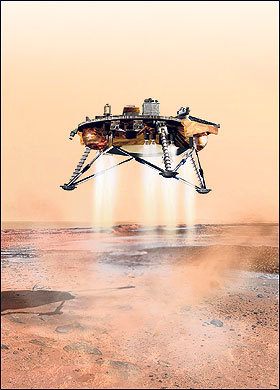
Proof ... NASA scientists detect
gas on the Red Planet
MARS is the fourth planet from the sun after the Earth.
DESPITE having a similar terrain — made up of mountains, deserts and polar icecaps — the Red Planet has virtually no water
THE planet’s reddish appearance is due to iron oxide.
WITH a surface area of 90million square miles, Mars is less than a third the size of our planet, which is 317million square miles
EARTH is 93million miles away from the sun, 135million miles closer than Mars.
FOR that reason, any inhabitants on the Red Planet will have to put up with average temperatures of -46°C. We earthlings usually bask in an average temperature of 14°C.
THE atmosphere on Mars is very different from ours — 95 per cent of the air is carbon dioxide, with the Earth’s being 78 per cent nitrogen and 21 per cent oxygen.
MARS does outdo us when it comes to satellites. It has two against our one — the moon.
By PAUL SUTHERLAND
Sun Spaceman
THE Martians that lie buried in the Red Planet’s soil may be simple microbes, but they show that our planet is not unique.
The humbling truth could be that life is a common feature that develops readily across the universe.
Experience has taught Nasa to be cautious, which is why some scientists still look for a geological explanation. They will not be certain until a probe has landed and captured some Martian organisms in its scoop.
In the past few years, astronomers have found 300 planets around other stars, telling us that solar systems like our own could be commonplace.
Chemical reactions that triggered the genesis of life on Earth could be creating alien creatures in habitable regions around those suns too.
Our Milky Way contains billions of stars. We know there are countless billions of other galaxies in the universe, each containing billions of suns of their own.
How many other worlds blessed with life must there be across the vastness of space?
The gas, belched in vast quantities in our world by cows, was detected by orbiting spacecraft and from Earth using giant telescopes.
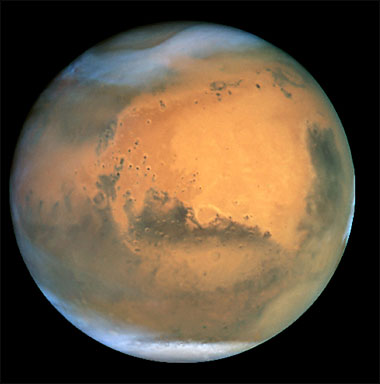
Discovery ... gas around Mars
Nasa are today expected to confirm its presence during a briefing at their Washington HQ.
And the find is seen as exciting new evidence that Martian microbes are still alive today.
To read more of our exclusive UFO stories click here.
Some scientists reckon methane is also produced by volcanic processes. But there are NO known active volcanoes on Mars.
Furthermore, Nasa has found the gas in the same regions as clouds of water vapour, the vital “drink” needed to support life.
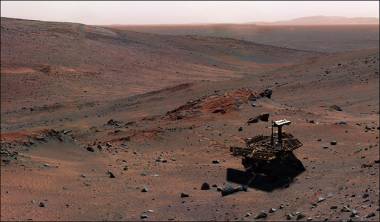
Mission ... probe on the surface of Mars
Experts speculate that the methane is being emitted as a waste product by organisms called methanogens living in water beneath underground ice.
And they would have to be alive today because the methane would otherwise have been lost from the Martian atmosphere.
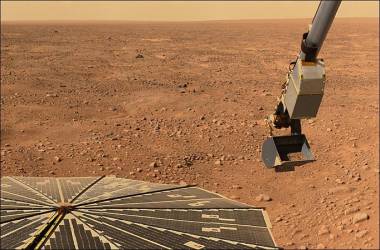
What a scoop ... Phoenix lander dug up chunks of ice last year
John Murray — a member of the Mars Express European space probe team — believes the mini-Martians may be in a form of suspended animation and could even be REVIVED.
He has found overwhelming evidence of a vast frozen ocean beneath the dust near the Martian equator where simple life could have thrived as microbes.
Today’s briefing will feature a star panel of Mars experts headed by Michael Meyer, chief scientist for Nasa’s Mars programme.
UK Mars expert Professor Colin Pillinger believes the methane can only point to the presence of life on the planet.
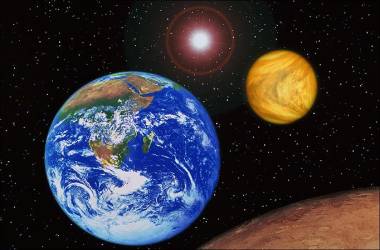
Space neighbours ... Earth and Venus rise over Mars in mock-up
His ill-fated Beagle 2 probe was carrying a laboratory that would have looked directly for such signs of life when it crashed on Christmas Day 2003.
Prof Pillinger told The Sun last night: “Methane is a product of biology. For methane to be in Mars’ atmosphere, there has to be a replenishable source.
“The most obvious source of methane is organisms. So if you find methane in an atmosphere, you can suspect there is life.
“It’s not proof, but it makes it worth a much closer look.”
Nasa’s findings confirm studies by Europe’s Mars Express probe, which has been orbiting the planet for five years and also reported signs of methane in 2004.
Britain’s top space expert Nick Pope last night hailed the new evidence of life as “the most important discovery of all time”.
He said: “What could be more profound than to know it’s not just us out there?

Expert ... Colin Pillinger
"We’ve really only scratched the surface — it’s an absolute certainty that there is life out there and we are not alone.
“If there is life on Mars then the logical conclusion is that there must be life elsewhere too.
“If it’s happened here on Earth, then why shouldn’t it happen anywhere? The implication is this is a universal law.
“Mars is very similar to Earth. It’s about the same size, it’s a rocky inner planet.
“Most scientists believe it probably has liquid water which is almost universally agreed as the pre-requisite for life. I am certain there is other life in the Universe and, most likely, intelligent life.”
The Red Planet has gripped the public imagination for more than a century as a possible home for aliens.
But life could not survive on its surface because, unlike the Earth, Mars has no magnetic shield to protect it against deadly sun radiation.
The planet resembles our own in many ways. It is made of rock, it has an atmosphere and weather systems.
Although much smaller with a diameter of around 4,222 miles, Mars’ day is just 40 minutes longer than ours and its tilted axis gives it seasons.
Water has been found in the form of buried ice and scientists believe that two billion years ago, Mars was covered with liquid oceans.
Proof that water is still on Mars came in 2007 when Mars Express used ground-piercing radar to study the region around the planet’s South Pole.
Nasa’s latest lander Phoenix dug up chunks of Martian ice last year. It swiftly evaporated into the thin atmosphere.
Nasa have controversially hit the headlines before for claiming evidence for Martians.
In 1996, they said they had discovered fossilised organisms in a meteorite from the planet.
But other scientists were sceptical.
Today’s conference will be broadcast live online by NASA TV (www.nasa.gov/ntv) at 7pm.
![]() Maybe the gas came from Uranus.
Maybe the gas came from Uranus.
posted by: Brightmeadows